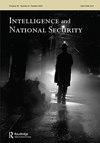欧洲人的间谍活动:冷战后欧洲的叛国与反间谍
IF 0.8
3区 社会学
Q1 HISTORY
引用次数: 0
摘要
随着乌克兰战争愈演愈烈,反间谍活动再次成为欧洲情报机构关注的焦点。尽管间谍威胁由来已久,但迄今为止,人们对招募的对象、他们的动机以及他们是如何被抓获的知之甚少。本文以2010-2021年的法庭定罪为基础,分析了针对欧洲北约和/或欧盟成员国的间谍活动。这是对欧洲当代间谍活动的第一次概述,并补充了以前的研究,这些研究主要是针对盎格鲁-撒克逊案件的单一案例研究。这项研究复制了对美国间谍活动的大量研究,发现了跨大西洋的共性,包括肇事者绝大多数是男性,中年,主要在国防或情报机构以外工作。但也存在差异,俄罗斯目前是欧洲间谍活动的主要发起者,北欧的案件高度集中,法律的多样性与法庭上同样不同的结果相吻合。总的来说,这些相似之处说明了当代间谍活动的本质,而这些差异主要归因于美欧之间的地缘政治差异。本文章由计算机程序翻译,如有差异,请以英文原文为准。
Espionage by Europeans: treason and counterintelligence in post-Cold war Europe
As war rages in Ukraine, counterintelligence has again taken centre stage for European intelligence agencies. In spite of the long-ascendant espionage threat, to date little is known about who is recruited, what motivated them and how they were caught. This article presents an analysis of espionage against European NATO and/or EU members, based on court convictions in 2010–2021. This provides a first overview of contemporary espionage in Europe, and complements previous research, which is dominated by single-case studies, mainly of Anglo-Saxon cases. Replicating large-N studies of American espionage, the study identifies transatlantic commonalities, including perpetrators being overwhelmingly male, middle-aged, and a mainly working outside of defence or intelligence agencies. But also differences, with Russia being by far the main instigator of espionage in Europe, a strong concentration of cases in Northern Europe, and a diversity of legislation coinciding with equally variable outcomes in court. Generally, the similarities speak to the nature of contemporary espionage, whereas the differences are chiefly attributable to geopolitical differences between the US and Europe.
求助全文
通过发布文献求助,成功后即可免费获取论文全文。
去求助
来源期刊

Intelligence and National Security
Multiple-
CiteScore
1.80
自引率
41.70%
发文量
93
期刊介绍:
Intelligence has never played a more prominent role in international politics than it does now in the early years of the twenty-first century. National intelligence services are larger than ever, and they are more transparent in their activities in the policy making of democratic nations. Intelligence and National Security is widely regarded as the world''s leading scholarly journal focused on the role of intelligence and secretive agencies in international relations. It examines this aspect of national security from a variety of perspectives and academic disciplines, with insightful articles research and written by leading experts based around the globe. Among the topics covered in the journal are: • the historical development of intelligence agencies • representations of intelligence in popular culture • public understandings and expectations related to intelligence • intelligence and ethics • intelligence collection and analysis • covert action and counterintelligence • privacy and intelligence accountability • the outsourcing of intelligence operations • the role of politics in intelligence activities • international intelligence cooperation and burden-sharing • the relationships among intelligence agencies, military organizations, and civilian policy departments. Authors for Intelligence and National Security come from a range of disciplines, including international affairs, history, sociology, political science, law, anthropology, philosophy, medicine, statistics, psychology, bio-sciences, and mathematics. These perspectives are regularly augmented by research submitted from current and former intelligence practitioners in several different nations. Each issue features a rich menu of articles about the uses (and occasional misuses) of intelligence, supplemented from time to time with special forums on current intelligence issues and interviews with leading intelligence officials.
 求助内容:
求助内容: 应助结果提醒方式:
应助结果提醒方式:


